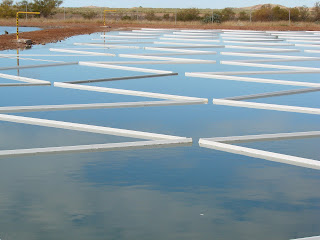
A new duckweed barrier water treatment system was installed for WA Water Corporation at Wickham in the Pilbara in mid June 2007, with the duckweed itself to be placed on site in July.
This is part of a serious evaluation of the concept for use in warmer areas of Australia where duckweed thrives year round.
The barriers provide the ideal still water conditions for duckweed growth in sewerage lagoons where there is adequate nutrients, plus plenty of sun, for growth. The duckweed aids in the elimination of the algal growth in the effluent which currently impacts effective reuse of the effluent for irrigation.
Currently the TSS level in the pond is very high [mainly algae], and it is expected that this will fall dramatically as duckweed growth accelerates and covers the pond. Reduction in bacterial levels are also expected, along with small reductions in nutrient levels [ which are still of benefit in most agricultural water reuse situations].
This is part of a serious evaluation of the concept for use in warmer areas of Australia where duckweed thrives year round.
The barriers provide the ideal still water conditions for duckweed growth in sewerage lagoons where there is adequate nutrients, plus plenty of sun, for growth. The duckweed aids in the elimination of the algal growth in the effluent which currently impacts effective reuse of the effluent for irrigation.
Currently the TSS level in the pond is very high [mainly algae], and it is expected that this will fall dramatically as duckweed growth accelerates and covers the pond. Reduction in bacterial levels are also expected, along with small reductions in nutrient levels [ which are still of benefit in most agricultural water reuse situations].
The photos are of before and after installation of the barriers. These systems significantly "quiet the water" , even with very windy conditions and allow for adequate growth of duckweed. Wind at the time of these photos was around 30km/hr.
